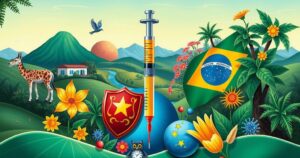New World Screwworm Emerges as Threat to Livestock and Public Health

The New World Screwworm fly has resurfaced after being deemed eradicated since 1966, prompting the USDA to halt imports of live cattle, horses, and bison from the southern border. The potential risks to livestock and humans are considerable, with the fly capable of causing severe damage through infestations. Risks are particularly high for individuals in certain vulnerable categories.
A concerning development for American livestock has emerged as the New World Screwworm (NWS) fly, previously thought eradicated in the country since 1966, has reappeared following an outbreak in Mexico. This resurgence has prompted the U.S. Department of Agriculture (USDA) to issue an immediate suspension of live cattle, horse, and bison imports through southern border ports. USDA Secretary Brooke Rollins made the announcement via social media, indicating the seriousness of the situation.
Rollins stated, “Due to the threat of New World Screwworm I am announcing the suspension of live cattle, horse, & bison imports through U.S. southern border ports of entry effective immediately.” The alarm is palpable, as this pest previously took decades to mitigate its impact on the cattle industry in the U.S.
So, what exactly is the New World Screwworm? According to the USDA’s Animal and Plant Health Inspection Service (APHIS), this fly is currently found in regions such as Cuba and certain South American countries, particularly in areas with livestock. The female flies notably lay their eggs in the openings or wounds of warm-blooded animals.
Once laid, the eggs hatch into maggots that burrow into the flesh, inflicting considerable and painful damage. These maggots, resembling how screws penetrate wood, are notorious for their destructive feeding behavior, which exacerbates injuries and invites more flies to lay eggs in the same area. This can, in severe instances, result in the larvae infecting humans, as mentioned by the Centers for Disease Control and Prevention (CDC).
The CDC raised alarms about the risk factors associated with exposure to these pests. Individuals traveling to regions where NWS is endemic, or those who spend time around livestock, are considered at higher risk, especially if they have open wounds. “Wounds as small as a tick bite may attract a female to feed,” the CDC noted. Vulnerable groups such as immunocompromised individuals, young children, the elderly, and those recovering from surgery are particularly at risk for infestations.
The USDA has issued stern warnings regarding a potential outbreak in the U.S., indicating that such an event could pose risks not only to livestock but also to pets, wildlife, and humans alike. Historical data suggests that during the 1950s and 1960s, livestock producers in the southwestern U.S. suffered annual losses ranging from $50 million to $100 million due to NWS.
If the current outbreak spreads beyond its containment, the economic impact could be severe. An earlier outbreak in the Florida Keys in 2016, which specifically affected the endangered deer population, serves as a reminder of how quickly these infestations can escalate and later be contained.
As the agency continues monitoring the situation, vigilance and preventative measures will be key in ensuring that the screwworm does not make a significant comeback in the United States.
In summary, the re-emergence of the New World Screwworm fly represents a significant threat to American livestock and the health of humans as well. Prompt actions, such as import suspensions, highlight the seriousness of the risk. As historical evidence suggests, the past impacts were severe, and proactive measures seem necessary to prevent future outbreaks and protect both the agricultural sector and public health.
Original Source: www.foxnews.com








